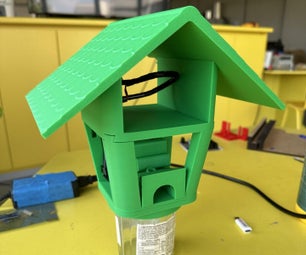Introduction: Tic-Tac TV Remote Jammer
That moment you take your eyes off the TV remote for just a second, because of which it falls into the hands of your annoying sibling. Yes, fighting for control over the TV is a daily struggle for many. But the TV Remote Jammer shown in this Instructable, will make everyone else stop dead in their tracks.
This Remote Jammer circuit, in the disguise of an inconspicuous TicTac Box, sends a constant signal to the TV receiver that interferes with the signal from the TV remote. This means that when the Jammer is on, your TV remote CANNOT be used to change channels. It practically blocks all signals from the remote.
This cheap circuit will make you the King of your TV; now you can watch your favourite shows without anyone disturbing you! And better still, no one will even know what's wrong. A small TicTac box would be the last thing that anyone would think of being the cause of their problem.
Let's dig into the details:
- What is a TV remote jammer? - A handy little circuit that blocks the signal from a TV remote, so no one can change the channel.
- Why a TicTac Box enclosure? - No one would be suspicious of your evil electronics skills.
How does it work?

Pretty simple. Have a look at this picture above. The usual TV remote sends a pulsed IR signal which has some instruction encoded in it, like increase or lower the volume, or changing the channel. This remote jammer, however, sends a steady IR pulse at about 40kHz. This pulse has no data encoded in it. Hence the TV receiver receives no instruction, even if some one else is frantically pressing buttons on the remote.
Step 1: Project Details:
Time: 3 hours max.
Cost: ~$10
Difficult: Modertely Easy
Skills Required:
- Experience with electronics
- Soldering
- Programming
Materials:
- An ATtiny13/45/85 chip - Preferably an ATtiny45
- IR LED - chances of this working are better if you use an IR LED salvaged from an old remote.
- Small Li-ion Battery (about 150-300mAh) - small enough to fit in a TicTac box
- Li-ion Battery recharge circuit
- General PCB
- PCB mountable switch
- Jumper wire
- TicTac box - or any enclosure you like; even a mini Altoids box will look great!
Step 2: Program the ATtiny: the Circuit...
Make connections on the breadboard as shown in the Fritzing diagrams above. Note that the wiring is different for Arduino MEGA and UNO boards.
Step 3: Program the ATtiny: Upload the Code...
Follow this guide to see how to burn the bootloader and upload the code to an ATtiny13 chip.
What is a bootloader? - If you're using the ATtiny chip for the first time, you probably have to 'burn the bootloader'. Basically the bootloader is a small piece of code that lets you run Arduino code on any microcontroller. It has to be uploaded or "burned" to the microcontroller's flash memory before uploading sketches.
For uploading the code to a different microcontroller, check out the following links:
- For ATtiny45
- For ATtiny85
- For ATtiny2313
- For ATmega8
Here's the code (suitable for an ATtiny13):
void setup(){
pinMode(1, OUTPUT);
}
void loop(){
digitalWrite(1, HIGH);
delayMicroseconds(12);
digitalWrite(1, LOW);
delayMicroseconds(12);
}If you have any other attiny with more than 2K of flash memory, the following code may work out better.
void setup(){
pinMode(1, OUTPUT);
}
void loop(){
tone(1, 38500); //adjust the frequency if it doesn't work for your TV
}Step 4: Solder the Circuit...
I soldered the entire circuit onto a general PCB about 2x2.5cm in dimensions. The circuit diagram is shown above. Note that I added an on/off switch which isn't shown in the diagram.
Here's an excellent tutorial on how to solder tracks on a PCB.
Step 5: Make an Enclosure...
The top white lid of the tictac box can be easily removed to put the circuit inside. In addition to that, I made a square hole using a cutter for placing the switch. See the pictures above for help.
After inserting the circuit and the battery, put the lid back on and glue it if necessary.
Step 6: Test It Out!
The IR led emits light at wavelengths not visible by the unaided human eye. However, most phone cameras can detect the IR rays; the IR will appear to glow purplish on the camera's screen.
Now let's test if your circuit actually jams the the tv remote. Keep the TicTac box in front of your TV receiver (or set top box), such that the lid is open and the LED is aimed at the receiver. Switch it on along with the TV. If the TV doesn't respond to any attempts for changing the channel or volume, then voila, it works!!!
Troubleshooting:
If the circuit doesn't jam your remote, try these steps to make it work:
- Check if the IR LED is working using your phone camera.
- Experiment with the frequency of the LED pulse. Try different values between 38 and 41kHz. (NOTE: This can only work with microcontrollers with more than 2K flash memory)
- Use another IR LED from an old remote, if you have used one from an electronics hobby store.
- Try using multiple LEDs in parallel to boost the signal.
WARNING: Test out your circuit in secret! You don't want anyone else knowing what you are up to!
Step 7: Recharging the Battery...
One thing I totally forgot before putting the circuit inside the enclosure is some connection so that I can recharge the battery. Most li-ion battery charger circuits are connected directly to the terminals of the battery, so no major soldering is required.
The remote jammer lasts for about 6 hours straight before its signal gets too weak to jam the TV.

Runner Up in the
Soldering Challenge











